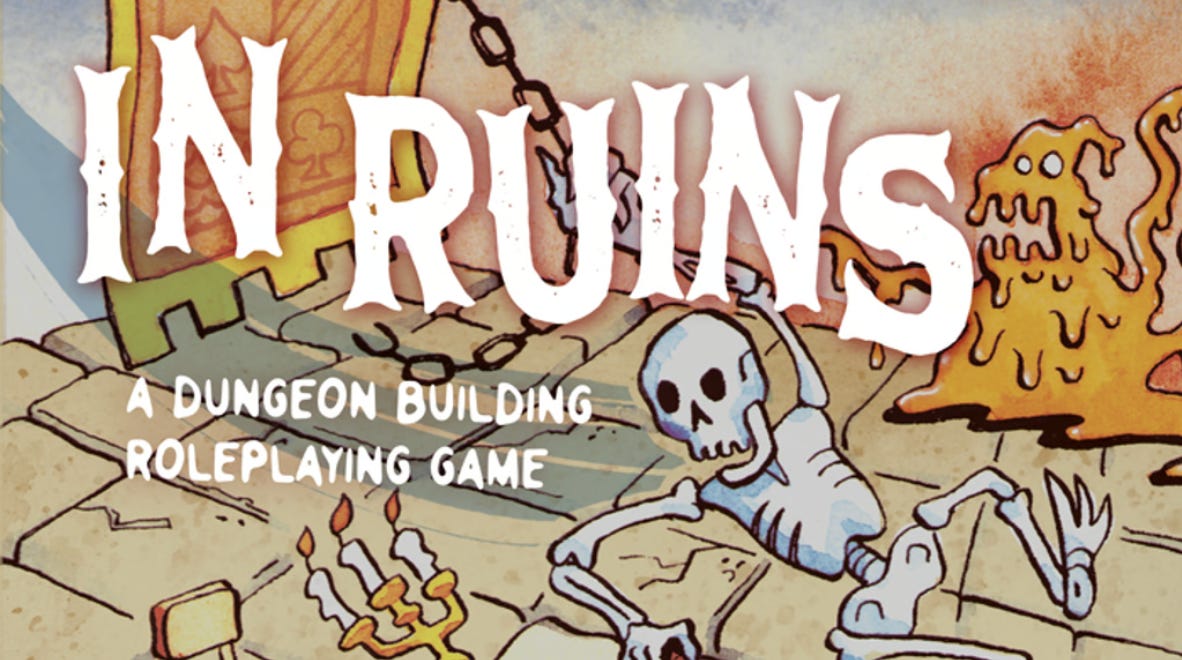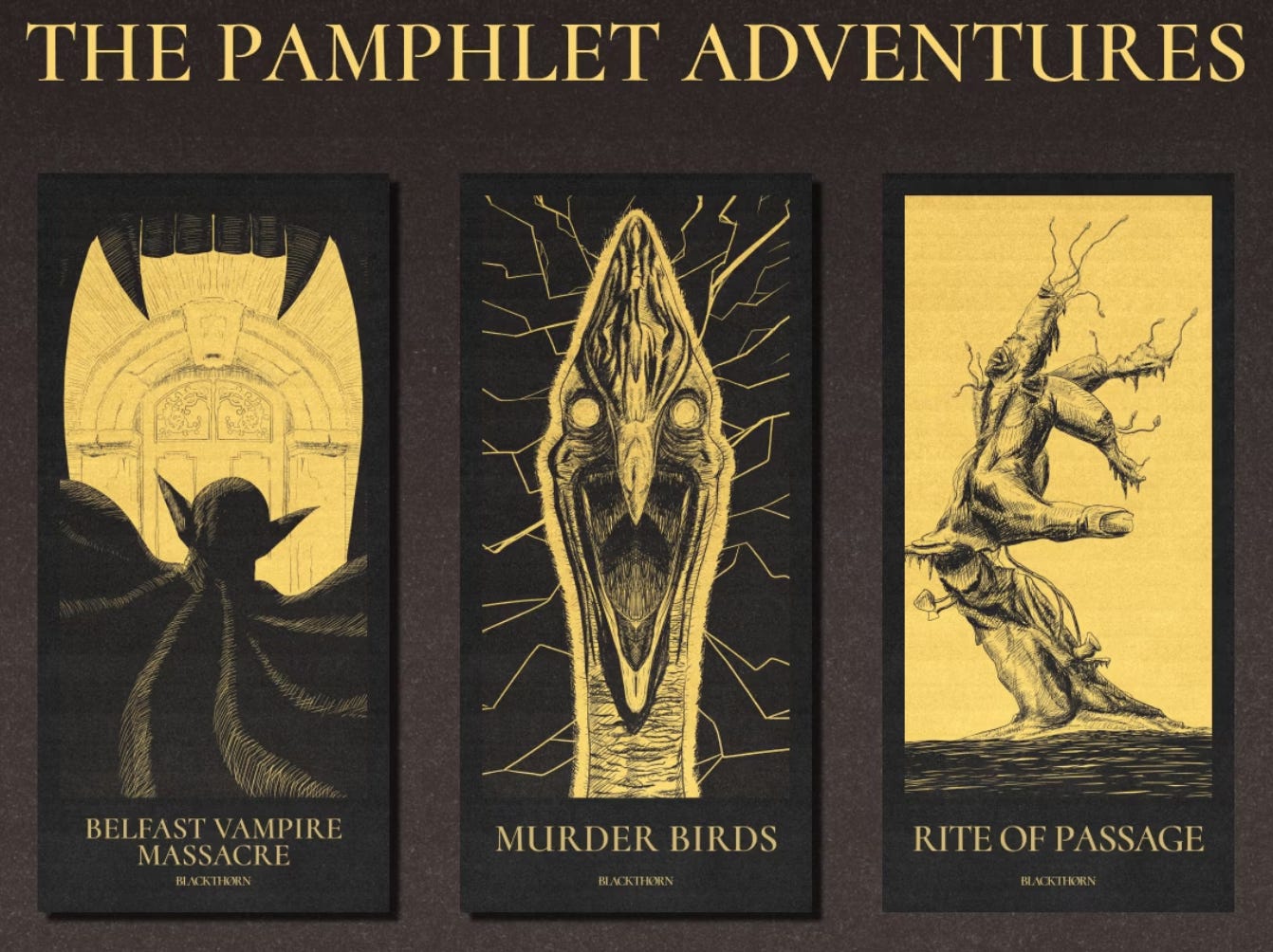Writing Letters
and In Ruins is wrapped!
Things were busy last month, so it’s been a little while since I talked about writing pamphlet adventures. Since then, In Ruins successfully funded on Kickstarter, I’ve written an adventure for a new horror game that’s on BackerKit right now, and I read a book that really set some cogs turning in the old think tank.
Inside
In Ruins
Rite of Passage for Blackthorn
Writing letters like This Is How You Lose the Time War
April Production Update
In Ruins
We did it! Last Tuesday, the Kickstarter for In Ruins finished, and we successfully funded the production of this game. With 577 backers, this turned into my biggest crowdfunding campaign ever.
I’ve finalized the game and placed the print orders for all of the different components that I’ll need to fulfill the campaign. The digital version should release at some point in April, both to backers and to the rest of the world, and I hope to crank through physical fulfillment before the arrival of summer.
Rite of Passage for Blackthorn
I mentioned some new writing gigs last time, and one of them has already launched onto the crowdfunding circuit. Blackthorn is a pulp horror TTRPG that is funding now on BackerKit.
I wrote a pamphlet adventure for this campaign called Rite of Passage. The characters in this adventure live in a town on the edge of a dark forest (I’ve been writing a lot of forests recently, haven’t I? No matter…), and a rite of passage for teenagers in the town is to spend the night in the forest looking for some bit of weirdness that they can brag about to their friends later.
Well, naturally, some teens have gone missing, and a group of their parents and some other concerned individuals are venturing into the forest to find them. Things are not going to go well for the characters, but that’s Blackthorn’s whole jam. If you are interested by the idea of a narrative-focused horror game with high lethality, definitely check this one out (the campaign ends Thursday, April 3).
Writing letters like This Is How You Lose the Time War
I recently picked up This Is How You Lose the Time War by Amal El-Mohtar and Max Gladstone. My copy looks like this:
Now, there is a lot to be said about this book (which I loved), but what I really want to focus on is the structure (also I would not want to spoil anything for anyone who will read it). I think it is spoiler-safe to describe the structure of this book as follows:
Chapter describing the actions of Character A that ends with finding a letter from Character B.
Chapter containing the text of the letter.
Chapter describing the actions of Character B that ends with finding a letter from Character A.
Chapter containing the text of the letter.
Repeat.
There are a few deviations, but for the most part, this is the structure of the novel. Many of the actions of the characters give them some idea of the actions of their counterpart, but for the most part, they are unaware of the details of their partner’s activities between letters.
It struck me that this could be the structure of an epistolary journaling game:
Player 1 journals. (The chapter of “Character A’s actions”)
Player 1 reads letter.
Player 1 writes letter.
Player 2 journals. (The chapter of “Character B’s actions”)
Player 2 reads letter.
Player 2 writes letter.
Repeat.
I have already written a handful of journaling games, so I have an idea of what they require (a few simple mechanisms and a lot of varied prompts and questions). At conventions, it is not uncommon to have people ask me if my journaling games can be played with 2 players. I usually give an answer to the effect of, “The games aren’t written that way, but you could certainly go through the steps of the game together, and either take turns answering the questions or answer them together as two characters experiencing the same events.”
Would that work? Sure.
Is that placing an extra burden on the player to adapt the game? Absolutely.
What would be a better answer to their question? How about, “Not that one, but this game is a letter-writing game designed for two players to exchange letters and tell a story over time.”
Of course, this is not a new idea. There are over 100 physical games tagged “epistolary” on Itch.io. I have read several games like this.
But for the sake of the inspiration from this novel, let’s consider what it would take to build the game that the 2 authors of the novel were playing when they wrote it. (They weren’t playing a game, that I know of. It’s just a hypothetical.)
1. Setting
Our game needs setting description. While there is little exposition in the novel to describe the setting (most of it must be gleaned from the actions and conversations of the characters), we would need to be much more up-front about the setting for our game. We would need to define the world and how it works, specifically with regards to time travel.
2. Character Creation
Hand-in-hand with the setting description would be character creation, in which each player chooses which faction they are connected to. We could use the structure of the novel to assist with defining the characters: each player would describe a particular event, either in childhood or early in their character’s time traveling, that proved formative for their personality. These would be kept hidden from the other player until revealing it made sense in the story.
We would also need to establish a relationship between the characters, which would tell us why they are writing letters to each other. This relationship could change (should change) over the course of the game.
3. Gameplay Loop
Now that we have characters, we can lay out the gameplay loop, similar to what I described from the book above:
Player A responds to a journaling prompt.
Player A writes a letter.
Player B reads a letter.
Player B responds to a journaling prompt.
Player B writes a letter.
Player A reads a letter.
This would repeat for the duration of the game. Now, this does not exactly match the pattern in the book, which jumped from a character reading a letter to the writer of the letter, but for creating the story in a linear fashion, I think this order of events would work well.
4. Prompts
Now we get to the most difficult/time-consuming part of the design: the prompts. Whether these are taken from a list in order (probably not), rolled from a table using dice (maybe), or linked to cards in a deck (probably), we will need enough prompts with enough variety that the game has some semblance of replayability.
We could use tarot cards, which gives the option of adding tarot interpretation into the responses (as in Endling).
We could have two completely separate sets of prompts, one for each character.
We could have sets of prompts that are used sequentially (take a prompt from list 1, then one from list 2, then one from list 3, and then the game ends).
However we structure them, the prompts will need to be interesting situations that the characters find themselves in that offer opportunities for the characters to undergo change/growth/development (you can read my thoughts on the importance of change in storytelling here). It would also be good if the events in the prompts lend themselves to interesting stories that could be included in the letters.
To match the structure of the book, each prompt would probably be a mission that the character is sent on to further the goals of their faction.
5. Mechanisms/Ending the Game
The final decision we would need to make as game designers is how to measure the progression of the game, and how to signal the end of the game. This could be developments in the characters’ relationship. This could be the success or failure of the characters as they seek to complete their missions. It could be the victory of one faction over the other, as determined by the actions of the characters, whether or not that is the outcome that the characters are working toward.
I can imagine each prompt coming with a challenge. The player can decide whether their character succeeds or fails at the challenge (I don’t think skill checks or dice rolling is needed here (I might be wrong; I’d have to do some play testing to see what is fun.).). The result would push the balance of power in the universe of the story one way or the other. If the balance does not move far enough in either direction within a set number of rounds (maybe 3-6?), everyone “loses.” If one faction can claim the upper hand, that faction “wins.” Any of these endgame situations could lend itself to a satisfying conclusion to the game, though not necessarily a “happily ever after.”
In Conclusion
I liked this book.
I think it would be cool to design a game that would facilitate the creation of a story like the one told in this book.
I don’t know if I’ll ever make such a game.
I hope this little exercise in game design was at least interesting, and maybe even useful, to you.
If you are a game designer, how would you write this game? What would you do differently from what I laid out here?
If you play journaling games, would you play this game?
shameless engagement fishing:
April Production Update
As mentioned above, In Ruins has moved fully into Production mode, and Fulfillment will be coming soon. Also, Rite of Passage is pretty much done from my side, and it will likely move off the grid once the Blackthorn campaign comes to a close.
I took out some of the Liminal Grimoire titles. Those are still very much alive, but they were taking up too much space on the grid. Only Witch’s Well remains, On Hold until it is (hopefully) unlocked as a stretch goal of the Liminal Grimoire BackerKit campaign, which launches April 15!
Not shown here is the additional writing that I am doing for Midnight Muscadines. This is the game that Starfall on Tyrian Peak and Cloudlight Cellar were written for. I am writing some of the setting material, tables of Key NPCs, Encounters, and Important Locations for a variety of towns and cities in that game’s main setting of Nimm. This game is ALSO going to be launching on April 15 (it’s going to be a busy few weeks on BackerKit!).
As far as planning goes, I am eyeing Auctoratus 2.0 as my next big project. We’ll also have to wait and see what else pops up over the next couple of months while In Ruins and Liminal Grimoire wrap up.
Thank You!
That’s all I’ve got for now. Thanks for reading!
—MAH







Not sure if you were aware, but there were TWO separate games in this ZineQuest based on this book:
https://www.kickstarter.com/projects/ickbat/against-time-and-death
https://www.kickstarter.com/projects/lunarshadow-designs/the-words-we-leave-behind
Solo journaling games as 2-player games - I think you might be overthinking that. What if the players were both related to each other such as in Caveat Emptor, the players could both be demons on probation in the same shop. They have their own customers but could talk about them and their curses. They could either be friends or rivals trying to thwart the other by giving bad advice.
Or in The Last Tea Shop, both players could have shops on the ethereal plane and discuss the comings and goings of their patrons. Or one player could be a patron lingering in the shop who also interacts with other customers.